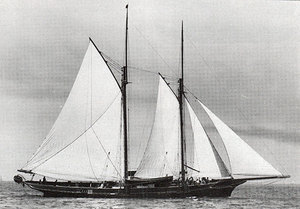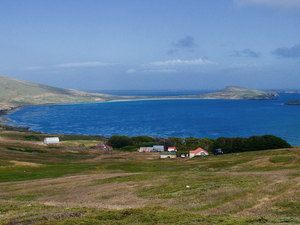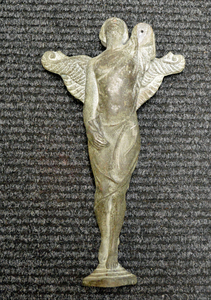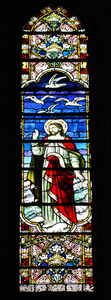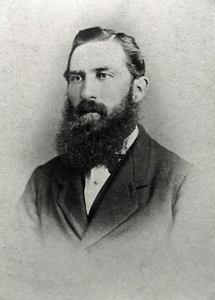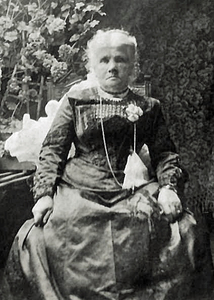HANSEN, CHARLES
c 1837 - 1891 from Denmark
sea captain and colonist, was a Dane from the Ditmarches, an area which today is part of northern Germany. Nothing is known about his family background, except that his father is curiously recorded as 'Matz Hanningsen, farmer', on Hansen's marriage certificate. Perhaps Hansen just tried to simplify his own name for English ears.
In 1860 he was a crew member of the brig Concordia of Hamburg, bound to Honolulu with general cargo. Thirty five days out from Río, they encountered heavy seas off Staten Island and in a letter written twenty years later to Sir William WISEMAN, Hansen described what happened:
The ship fortunately had a light cargo and was very buoyant, but she laboured so heavily that the wind had no power on her, the overfalls rolling over her with violence. With great difficulty we got more sail on her and got her before the wind. After we got out of it, we sounded the pumps and found three feet of water in her and a lot of bulwarks and stanchions gone. We ran for the Falkland Islands and on the second morning after we abandoned the ship at sea, there being seven feet of water in her when we left.
James LANE, FIC colonial manager, was also acting consul for Hamburg, and on 16 October 1860 he wrote to Governor MOORE:
I beg to make known to Your Excy the arrival in the Port of the Captain and 12 hands of the Hamburg Brig Concordia ... the Brig was abandoned and sank within sight of the Captain and men (in the boat) 70 miles SW of Speedwell Island and they reached Stanley, after being 12 days at sea, this morning.
Most of the crew were repatriated, but Charles Hansen decided to stay in the Falklands and Lane gave him employment with the FIC.
In 1866 Hansen bought the schooner Felis in Montevideo and started trading around the Falklands, working the dangerous shores of the Jason Islands for penguin oil and sealing on the coast of Patagonia. He sailed the Felis for three years and in 1868 rescued 24 men of a shipwrecked crew and brought them to Stanley.
In 1869 he acquired the larger schooner Louisa, which had belonged to Jacon Napoleon GOSS. Both boats were registered under the British flag, as Hansen claimed to be from Heligoland (then a British colony). Between 1870 and 1872 he was occupied with salvage work on the English 599-ton barque Balcarry, wrecked in Tierra del Fuego, and finally managed to re-float the ship and sail her back to Stanley. In 1871 he rescued a number of shipwrecked sailors from a beach in Tierra del Fuego and in September of that year Governor D'ARCY wrote to the Colonial Office describing the difficulties and dangers Hansen had endured in his efforts to locate the crew of yet another wrecked ship, the American barque Italia.
I have detailed this occurrence somewhat at length to prove to Your Lordship what bold and gallant sailors the inhabitants of these Islands are and the personal risks they run on such occasions, leaving no course untried when there is the smallest chance of saving life.
Again in 1873 he sailed in the Louisa to rescue the crew of the Neptune of Sunderland, wrecked on Kelp Island.
On 18 March 1869 at Holy Trinity Church, Stanley, Hansen married Julia Sarah Spittle, who had come to the Falklands with Governor ROBINSON in 1866, as nurse to his children. The Hansens had five children, Julia Maria (b1869), Fredericka Kate (b1871), Charles (b1873) and twins Jason and Stanley (b1881).
In 1872 he took a lease of Carcass Island and all the Jasons and succeeded in clearing Grand Jason of goats which the sealers had left there, replacing them with sheep. He stocked Carcass with sheep and cattle and went to live there with his family in 1875.
In 1879 he wrote a long appeal to the governor, confessing that he was in fact Danish and asking for naturalisation as a British citizen. An ordinance granting this was passed by Legislative Council the same year.
In the late 1870s Hansen bought Lord Dufferin's famous yacht, the Foam, which had served as the government mail schooner between 1864 and 1872. However sadly the boat was lost in 1890 when she went ashore on Carcass Island. Her figurehead is in the Museum in Stanley.
Charles Hansen was drowned in October 1891, when he fell overboard while taking a sight from the schooner Result, on a return voyage from Patagonia.
Both Grand and Steeple Jason were purchased by Hansen's widow after his death, together with Carcass and she managed the islands until her sons were able to take over. The Jasons were sold to Dean Brothers in 1927, but Jason Hansen and his wife Daisy continued to farm Carcass until Jason died in 1952 when the island was sold to Kitty and Cecil BERTRAND and Adrian MONK.
There is a memorial window to Charles Hansen in Stanley Cathedral, placed there by his widow in 1899. It shows Christ walking on the water and has the following inscription: 'In affectionate and grateful remembrance of Charles Hansen who was lost at sea thereby entering into the rest that remaineth for the people of God. October 1st 1891. Aged 54'.
References
Sydney Miller; Captain Charles Hansen - Letter to Admiralty 1882; Falkland Islands Journal; 1977
Kit Layman and Jane Cameron; The Falklands and the Dwarf: the cruise of HMS Dwarf in the Falkland islands 1881-1882; Picton Publishing; 2009
Comments
Revisions
May 2019 Photograph added
November 2019 Three additional photographs added; two references added
March 2020 Death date corrected; one additional photograph added
May 2020 One additional photograph added
